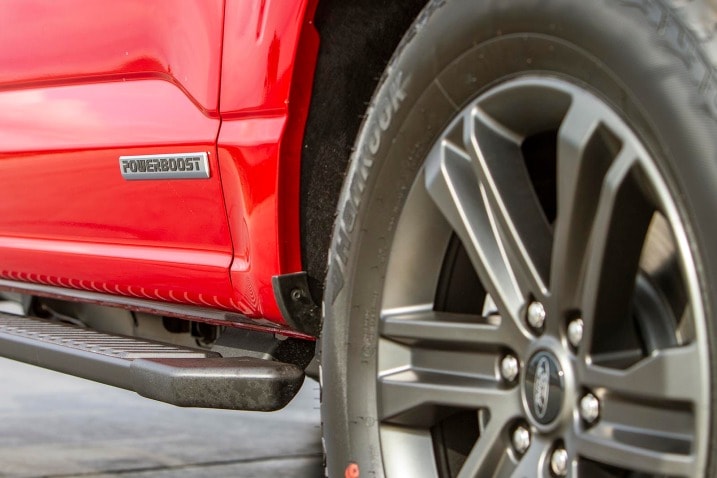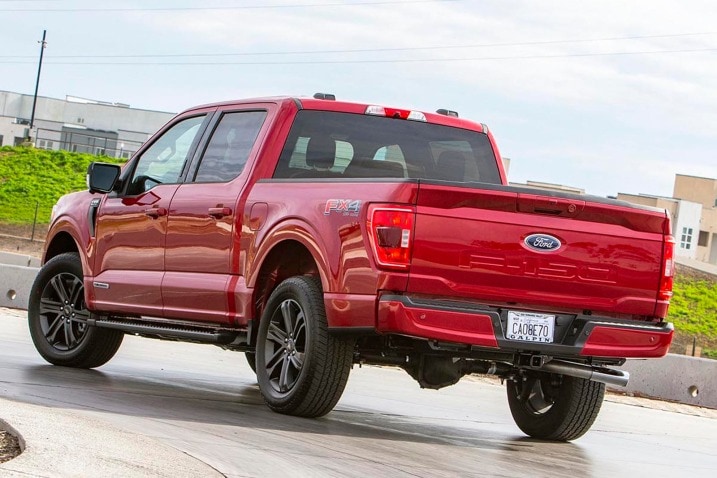- Our F-150 Hybrid achieved the EPA-rated 24 mpg only twice.
- Our previous 2018 F-150 EcoBoost's fuel economy was also below estimations.
- The F-150 Hybrid excels at putting down the power though — it's faster than an F-150 Raptor.
Our Ford F-150 Hybrid Is Far Thirstier Than Its EPA Figures Suggest
Power: Yes! Fuel economy: It's complicated
Six months have passed since we purchased a 2021 Ford F-150 Hybrid. This is the fourth F-150 added to Edmunds' extensive library of long-term test vehicles over the years. Now at 10,000 miles, its story is becoming clear. The hybrid's real-world fuel economy is 5 mpg below EPA claims, a trend that reminds us of a 2.7-liter F-150 we tested for 42,000 miles in 2018. Yet this hybrid truck also handed an F-150 Raptor its lunch in a drag race. So what is the hybrid really good for?
Not 24 mpg
A window sticker sets expectations for a vehicle, but now we're finding that the EPA's fuel economy estimates can be just as unrealistic in real life as the MSRP. The EPA rates the F-150 Hybrid (this powertrain is also known as the PowerBoost) at 24 mpg combined (24 city/24 highway). But we aren't getting that in our long-term truck. Not even close.
Our average fuel economy over 10,000 miles, six months and 30 fill-ups is a disappointing 19.3 miles per gallon (excluding towing and performance testing). If we averaged 19.3 mpg in any ordinary full-size pickup, we'd be thrilled. But this powertrain is a $4,000-plus line item, and this truck, to date, has hit an average of 24 mpg per tank just twice and 23 mpg twice. Most fills are in the high 18s. From this perspective, we only get what we paid for 13% of the time, and we really have to drive a particular way to get that. This engine is finicky in that sense, but the end result is clear: It's not 24 mpg. We will admit that our pickup's towing-optimized 3.73 axle puts us at a slight disadvantage with respect to achieving the best fuel economy, but the change shouldn't amount to such a deficit.
We've seen this before
This situation is a reflection of more than the hybrid system itself. In the past we have also owned a 2018 EcoBoost F-150, which is fundamentally a very similar vehicle, but with the turbocharged 2.7-liter V6 and, of course, no hybrid boost. After 42,000 miles, we averaged 17.7 mpg, excluding towing, with a best fill of 21.7 mpg. The EPA prepared us for 21 mpg combined (19 city/24 highway). Overall, the truck's average fell short by 3 mpg and was never close to the highway claim. Time and again we've seen these EcoBoost engines require a driving style that we have yet to master. F-150 owners forums suggest we aren't alone.
But, man, can it go
We've established that these EcoBoost engines require an oftentimes unnatural finesse to drive efficiently. Where they don't need help is with power. For example, the PowerBoost F-150 has 430 horsepower and 570 lb-ft of torque. This is really why you buy the hybrid — if you're in it for the pulling power, this is your truck. Heck, we recently filmed a series of desert drag race videos using our F-150 Hybrid to carry gear as a support vehicle. We decided to call it off the bench to go against an F-150 Raptor. To many of our surprise, the hybrid won three consecutive races, convincingly. It seems to us that this hybrid is more about performance than sipping fuel.
Edmunds says
We've been conditioned to accept that attaching the word "hybrid" to a car elevates it to fuel-sipping status. Sometimes we forget why they are more efficient. That battery-derived torque at low speeds, when the engine benefits from it most, is what it's all about. If you are towing a trailer, hauling a heavy payload or drag racing your buddy's Raptor, the F-150 Hybrid's torque is your friend. For that, we are really digging this PowerBoost F-150. Still, when we look at a window sticker and see a claimed mpg, we have an expectation. This truck isn't meeting that.








 by
by